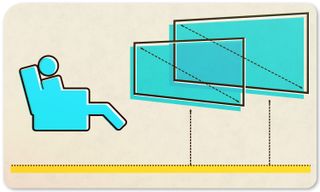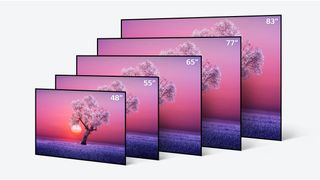What size TV should you buy?
What size TV do I need? How to figure out the right size of TV for your space and comfort.

Not sure which TV size to buy? We've all been there before. As TVs are getting bigger, it can be hard to know what the best size TV might be for your particular setup. But we're here to help you uncover what size TV should you buy, unlocking the fullest potential of your home entertainment setup.
As TV testers and reviewers, we know exactly where to look when it comes to this question. We see all kinds of displays, from Mini-LEDs to OLED TVs, each of which has their own many sizes and advantages / disadvantages.
We have a handy guide below, but if you want to do your own calculations, you want a TV to fill about 40% of your field-of-view from wherever you're sitting.
| Distance from TV | Minimum screen size | Sweet Spot | Maximum screen size |
| Between 2 and 3 feet | 25 inches | 32 inches | 40 inches |
| Between 4 and 5 feet | 30 inches | 42 inches | 50 inches |
| Between 6 and 7 feet | 45 inches | 55 inches | 70 inches |
| Between 8 and 9 feet | 60 inches | 75 inches | 85 inches |
| Between 10 and 12 feet | 75 inches | 85-inches | 98 inches |
The technical answer may not always make sense for your personal space and eye comfort. Therefore, we really recommend measuring the space to see what will look good there and what feels like it's comfortable before buying a new TV. (Moving into a dorm? Read our guide on what TV size will you need for your dorm room.)
- Check out the best TVs we've reviewed
- TV shopping? Everything you need to know about buying a TV
- The best TV mounts to hang your set on the wall
Now that you know which size TV you should buy, we’ve pulled together all our top tips for choosing the right size TV for you, your room, your needs, and your budget. This guide is intended to help you with your primary, family room television, but the same principles will work for your bedroom, den and office.
What size TV do I need? Quick Tips
Why you can trust Tom's Guide
Understand screen size. TV screens are measured diagonally from corner to corner, so a 65-inch TV is closer to 55 inches wide. Bigger is better, in most respects — it's more immersive and easier to see, not to mention more impressive when showing off to the neighbors. But if the screen's too big, it won't fit in the space you have.
Know your resolution. TVs today offer three resolution options – 1080p, 4K and 8K. We recommend 4K for pretty much everyone, but the resolution will change how close you can sit to a set and how expensive it will be.
Figure out room size and position. Rooms don't get bigger to accommodate larger TVs, so find the right size for your space.
Screen size and resolution
First, remember that TV screens are measured diagonally. So a 55-inch screen measures 55 inches from one upper corner to the opposite lower corner. But the actual dimensions will be different, measuring roughly 49 inches wide and 29 inches tall.
Screen size has a direct relationship with the optimal viewing distance. Larger screens are best watched from farther back; otherwise, you can find yourself unable to see the whole picture, or experience unwanted distortions and color issues from sitting too close.
Next, you have to consider the resolution of the TV. TVs today offer three resolution options — 1080p, 4K and 8K. The higher the resolution, the closer you can sit before you'll notice pixelation in an image. That means you can sit closer to a 4K TV (3840 x 2160) than you could a 1080p TV.
We recommend 4K for pretty much everyone, but the resolution will change how close you can sit to a set and how expensive it will be. Here's how the main resolution options break down:
1080 or Full HD: Display resolution measuring 1920 x 1080 pixels, used in modern television broadcasts, cable and satellite TV, Blu-ray media and available broadly in free and paid streaming services. You'll still see these, especially when you go looking for the cheapest TVs on sale. Full HD is a good choice if you're getting a TV with an extra-small screen, but for anything larger than 40 inches, you should be getting 4K.
4K (Ultra HD): Display resolution measuring 3840 x 2160 pixels, commonly referred to as Ultra HD or UHD. The current standard in smart TVs, offering 4x the resolution of full HD. We strongly recommend 4K for everybody, in most situations.
8K (Ultra HD): The next step in resolution is 8K, or 7680 x 4320 pixels. It's also called Ultra HD (just like 4K), so don't be confused. There's also a severe lack of 8K content, so we recommend skipping 8K this year. Even on sale, it's more expensive than an equivalent 4K TV.
Check out the top TV models in either resolution:
The best 4K TVs | The best 8K TVs

Room size and TV position
Rooms don't get bigger to accommodate larger TVs, so find the right size for your space. Screen size has a direct relationship with the optimal viewing distance. Larger screens are best watched from farther back; otherwise, you can find yourself unable to see the whole picture, or experience unwanted distortions and color issues from sitting too close.
Consider the room in which the TV will sit. As long as the furniture in that room is not permanently attached to the floor — and you're willing to move it — then you have some flexibility in the size of the TV you can get.
There’s also the question of whether you plan to set up the TV using the included stand or use a wall-mount to hang it. Using the included stand to set the TV on a table or entertainment unit will place the set closer to the viewer, shortening the viewing distance. Be sure to account for both the depth of the TV stand and whatever furniture you plan to set it on. Some sets have relatively narrow stands, but others, like the 65-inch model seen in our Samsung QN90A Neo QLED TV review, extend back nearly 9 inches with the stand attached. Similarly, the 65-inch model from our TCL 6-Series Roku TV (R635) review is 13.7 inches deep, despite the TV having a 2.8-inch thick chassis.
Hanging the TV on the wall, on the other hand, can add a foot or more to the viewable distance, which can be the difference between a 60-inch TV and a 72-inch model. (Check out the best TV mounts for our favorite mounting hardware.) Depending on what sort of mount you use and the thickness of the TV, your screen will still sit a few inches from the wall, but the specifics will vary from one model to the next. Some, like the LG G1 OLED TV are designed to mount flush against the wall, but most will still need some space to accommodate mounting hardware.
MORE: Best Viewing Angle and Height to Mount Your TV
What's comfortable for you?

The typical TV-watcher sits 9 feet from the screen, which brings us to the comfort factor: Most people like to sit far enough away from a TV that the pixels on the screen can't be distinguished. So, feel free to experiment with the placement of your new TV, and it never hurts to go a little bigger than what you think you'll need.
Whether you're shopping for a TV for your home or a home for your TV, you can now figure out the perfect viewing distance with just a couple of quick calculations.
If you've narrowed down your TV shopping by brand, price range or screen size, check out our picks for the best TVs in each.
Best TVs | Best 4K TVs | Best smart TVs for streaming | Best TVs for gaming
The best TVs under $1000 | The best TVs under $500
Best TV brands | Best Samsung TVs | Best TCL TVs | Best LG TVs | Best Roku TVs | Best OLED TVs | Best QLED TVs | Best 8K TVs | Best HDMI 2.1 TV | Best TVs with ATSC 3.0 | Best TVs with Chromecast
The smallest smart TVs | Best 43-inch TVs | Best 50-inch TVs | Best 55-inch TVs | Best 65-inch TVs | Best 70-inch TVs | Best 75-inch TVs | Best 85-inch TVs
And don't forget to watch out for the latest TV reviews.
Sign up to get the BEST of Tom's Guide direct to your inbox.
Here at Tom’s Guide our expert editors are committed to bringing you the best news, reviews and guides to help you stay informed and ahead of the curve!

Nick Pino heads up the TV and AV verticals at Tom's Guide and covers everything from OLED TVs to the latest wireless headphones. He was formerly the Senior Editor, TV and AV at TechRadar (Tom's Guide's sister site) and has previously written for GamesRadar, Official Xbox Magazine, PC Gamer and other outlets over the last decade. Not sure which TV you should buy? Drop him an email or tweet him on Twitter and he can help you out.
- Ryan EppsStaff Writer
- Brian Westover